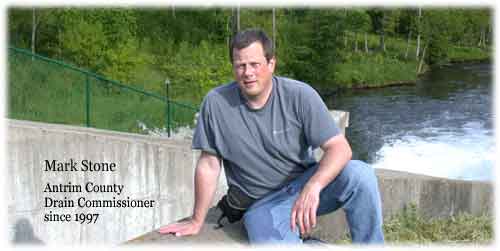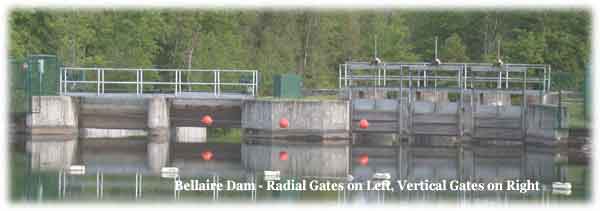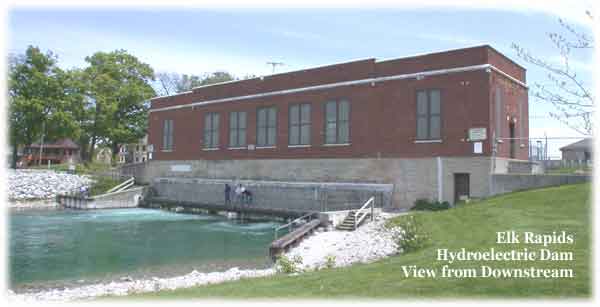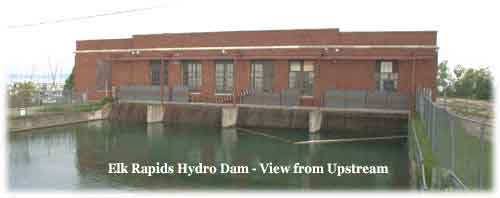(Revised July 15, 2012)
TABLE OF CONTENTS
• What does the Antrim County Drain Commissioner do?
• What
does the Operator of Dams do?
• What’s it like to be
the Operator of Dams?
• Tour the Bellaire
Dam.
• Tour the Elk Rapids Hydro
Dam.
• Why doesn’t the
Antrim County Drain Commissioner handle drainage issues like drain
commissioners downstate do?
• How to Contact the Drain Commissioner or Operator of Dams.
• Biographical Information on Mark Stone
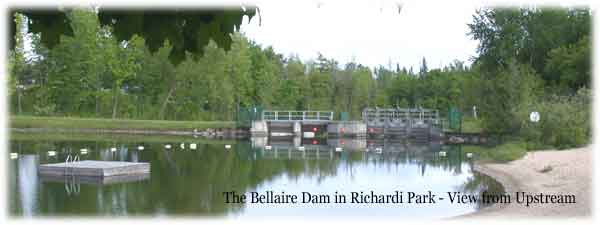
What
does the Antrim County Drain Commissioner do?
Technically speaking, the Antrim County Drain Commissioner
has nothing to do. That's because Antrim County has only one legal drainage
district around Birch Lake that rarely requires attention. (The Birch
Lake drainage district was established as a legal mechanism to create
a pump system to transfer sewage from the lakefront homes to the Village
of Elk Rapids' waste treatment plant.) With no significant drainage district,
the drain commissioner has virtually no statutory duties under the Michigan
State Constitution. Nevertheless, in a quirk of State law, Antrim County
is still required to have a Drain Commissioner.
Many years ago, the County Board of Commissioners decided to assign the Drain Commissioner some non-statutory duties. At the time, it probably seemed like a good move: we had a drain commissioner, so let's give him something to do. Specifically, they delegated the operation of the Bellaire Dam and provided a small salary for the work. It's important to understand that these duties are non-statutory, they could be revoked at any time by the Board, and are non-political. This was the status of the job when I was appointed the position in 1997.
Since 1997, the responsibilities of the job have grown quite a bit. First, I was asked to handle the administrative duties at the Bellaire Dam, which include dealing with long term maintenance, construction projects and meeting the regulations set by the Dam Safety Division of the Michigan Department of Environmental Quality. Later, the management of the Elk Rapids Hydroelectric Dam was assigned to me. The Elk Rapids facility turned out to be an administrative tangle of poorly written contracts, huge financial liabilities and an ongoing budget loss for the County. It took many years to sort out. One thing led to another, until the job of running the dams reached a point where it needed to become a permanent County position.
After many months of work, the County Board of Commissioners formally created the Operator of Dams as a County employee. The County Drain Commissioner position still exists, but the salary has been reduced to $500 per year and the Drain Commissioner no longer is involved in managing the dams.
I continue to seek election to the post of Antrim County Drain Commissioner for two reasons: 1) After learning how powerful a drain commissioner can be in the State of Michigan, I believe the expansion of this post would be counter to the best interest of Antrim County. I would like to reduce the salary to $1 per year. I do not support the formation of a new drainage district around the Antrim Chain of Lakes that would create a new way to raise property taxes (as some people have proposed). 2) Since so many Antrim County residents still associate the Drain Commissioner with the dams, I would like the next four years to continue educating people that the dams fall under the County Board of Commissioners, not the Drain Commissioner.
What does the Antrim County Operator of Dams do?
Antrim
County owns two dams: the Elk Rapids Hydroelectric Dam and the Bellaire
Dam. The County is also obligated by court order to maintain the water
levels on the two lakes formed by the dams: Elk
Lake and Intermediate Lake. The County Board of Commissioners
assigned the task of maintaining those levels, and the dams, to the
Operator of Dams. The Operator of Dams is overseen by the Public Works
Committee of the County Board of Commissioners. I hold the position
of the Operator of Dams for Antrim County.
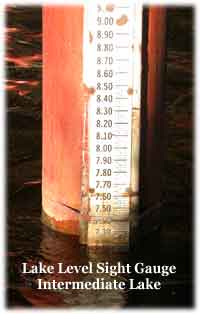
In order to supervise and operate the dams, the Operator of Dams
maintains a small budget which is part of the County’s General
Fund. The Operator of Dams has no employees, but gets secretarial support
from the County Planner’s office and lawn maintenance support
from the County Building Maintenance Dept. Each year, the Operator
of Dams provides an Annual Report to the County Board and meets with
the Public Works Committee as necessary. He also maintains a small
office on the second floor of the County Building. The position is
part time only and most of the work is performed at the dams.
The Operator of Dams operates the Bellaire Dam himself. (The Bellaire
Dam is located in Richardi Park, near the swimming beach and picnic
area.) The dam consists of an earthen berm with 5 electrically powered
gates set into a concrete structure. The gates must be operated on
site to increase and decrease the flow of water from Intermediate Lake
in order to maintain the court ordered lake level. The level is measured
at a gauge located near Central Lake.
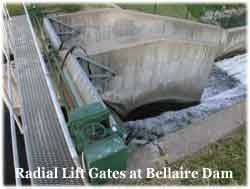
The Elk Rapids Hydroelectric Dam is operated under contract by Elk Rapids
Hydroelectric LLC (ERH).
This dam maintains the court ordered level for Elk Lake. The Operator
of Dams acts as supervisor of the contract and liaison with ERH. Since
the facility is County property, the Operator of Dams is also responsible
for community relations, periodic maintenance, and regulatory inspection
of the Elk Rapids Dam building and the equipment.
Both dams require routine safety inspections by the Department of Environmental
Quality, and in the case of the Hydro Dam, the Federal Energy Regulatory
Commission (FERC). The inspection process necessitates the hiring of
engineers and often the bidding of contracts for larger maintenance projects,
which is handled by the Operator of Dams and authorized by the County
Board.
In addition, the Operator of Dams is the principal responder to emergencies
at the dams and responsible for coordinating other agencies. In the
past fifteen years, several equipment emergencies have occurred at the
dams.
What’s
it like to be Operator of Dams?
People who don’t live on the lakes in Antrim County might be surprised
at how passionate some of our residents are about the lake levels. Most
of my interaction with the public is fielding questions and complaints
about that subject. About half the people that complain feel the level
is too high, and the other half feel the level is too low. In most cases,
there is little I can do but explain the process of maintaining the lake
levels.
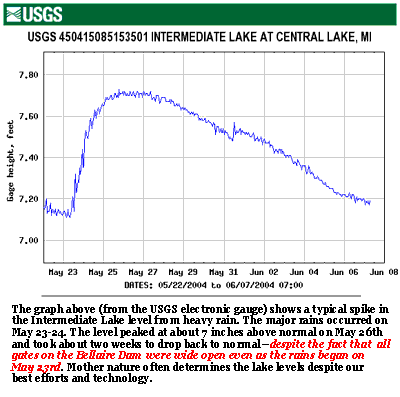
For instance, the levels of only two lakes are directly controlled by
the dams and yet I field calls from residents on many of the lakes in
the County where the dams have little or no effect. Even though the
court has established legal levels on Elk Lake and Intermediate Lake,
nature doesn’t always cooperate with the court orders. The volume
of water we can move through the dam after a heavy rain is not sufficient
to drop the surface to the legal level immediately—it may even
take weeks on Intermediate Lake —and
opening the dams too quickly can also have consequences. Operating the
dams and maintaining the levels is a balancing act of the first order.
Since taking office fifteen years ago, both dams have undergone several
rounds of careful inspections and a considerable amount of repair and
refurbishment. You may have noticed a few years ago, when we replaced
the old cyclone fencing around the Bellaire Dam compound and removed
the unsightly and dangerous barbed wire. At the same time, entire areas
of the concrete abutments were resurfaced to treat damage from the constant
flow of water. (All this work was paid for with a FEMA grant thanks to
the help of the Antrim Conservation District—no Antrim tax dollars
were necessary.) Of course, like all mechanical parts, the motors, gears
and fittings on the dams are in need of routine maintenance, and these
parts are checked on a regular basis.
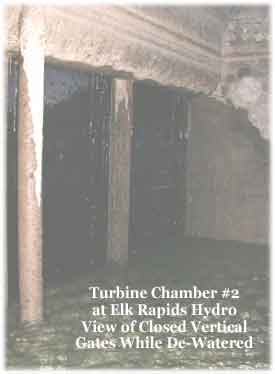
Technological improvements have improved our ability to reduce the fluctuation
of the lake level in Intermediate Lake. Through the funding of another
grant, the U.S. Geological Survey installed an electronic lake level gauge
which allows the Dam Operator to check the level by way of the internet
from any location. It also records the level over time, which offers the
ability to assess the speed with which the water level rises and falls
in relation to the changing of the gates.
Prior to 1997, no records of lake levels were ever compiled. The electronic
gauge on Intermediate Lake now automatically records the level each
5 minutes and we also record each change in the position of gates on
the dam.
The Elk Rapids Hydro Dam presents the greatest administrative challenge.
As a power generating facility, the dam falls under the regulations of
the Federal Energy Regulatory Commission (FERC). It’s hard to explain
how complicated the FERC paperwork, inspections, etc., associated with
owning a hydro dam can be, and to complicate matters, we also come under
the oversight of the Department of Environmental Quality.
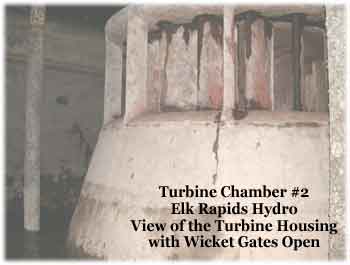
The Hydro Dam is operated under a complicated contractual agreement with
Elk Rapids Hydroelectric (ERH). The Hydro Dam is monitored by the ERH
twenty four hours a day and ERH performs the routine
maintenance on the generating equipment as well. However, Antrim County
maintains the building and impoundments and occasionally brings in outside
contractors to perform larger maintenance tasks.
It took several years to fully understand all the administrative and
equipment operation of the Hydro Dam and even today, we’re still
learning more as we go. Just as at the Bellaire Dam, the Hydro Dam requires
regular maintenance work. Most recently, we have contracted a firm to
repoint and repair the masonry on the building. We are also reconstructing
and repairing cement work.
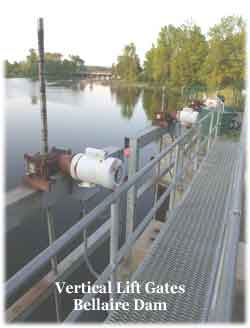
Admittedly, I love this job. From an early age and into college I worked
in our family business, a marina at the mouth of the Detroit River. It
was a wonderful education for learning how to work in and around water,
including marine construction, hydrology, and all the related trades.
We also lived on the river, where I spent virtually all my free time as
a youth, exploring, fishing and duck hunting. So, it takes little effort
to drive down to the dam at any hour of the day or night and adjust the
gates—just listening to the water fall through the sluice way is
a reward in itself.
It's important to note that the Operator of Dams is not a political
position. I focus only on where the lake level should be according to
the legal court-ordered level. The
last person that should have an opinion on raising or lowering the level
should be the guy in charge of maintaining the level after it is established.
Besides, we already have an active and ongoing political debate in
Antrim County, it occurs at the County Board of Commissioners. The
Board is the place to debate the issues of our time—they set the
policy, they set the budget, they instruct the staff. Once the Board sets
the policy, the Operator of Dam’s job is to expedite the policy
in a fair and efficient manner.
Tour
the Bellaire Dam.
As noted above, the Bellaire Dam is located in Richardi Park, near the
swimming beach and picnic area. The original dam was constructed soon
after the first settlers arrived in the area to power the local sawmill
and back up Intermediate Lake to make it easier to float logs from the
adjacent areas. Richardi, the park’s namesake, was the owner of
the woodenware factory that was located on the site of the park and the
man responsible for first fitting the dam with equipment to generate electricity.
Ironically, at first the power was not used in Bellaire, but a transmission
line carried the electricity to Charlevoix where it was used to provide
some of the first public lighting with electric bulbs (reputedly the first
such use of electricity in Michigan).
The Bellaire Dam continued to generate power well into the last century
and was finally decommissioned some time in the 1950s. The three concrete
chutes with vertical gates on the west side of the dam date to the era
of power generation, during which they served as the overflow gates in
case of floods. The two radial arm gates and their concrete chutes were
installed around 1980 and replaced the structure that housed the water
turbine and generators.
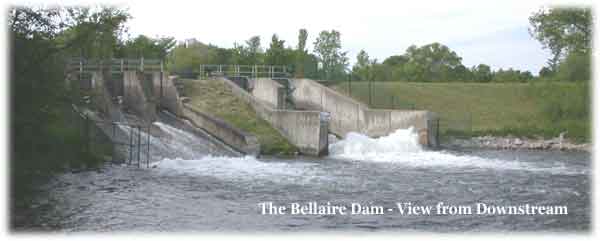
The summertime water
level of Intermediate Lake was established by a circuit court order at
607.15 feet above sea level in 1986. On November 1st of each year, the
order calls for the level to be dropped to 606.54. The following spring,
the lake level is raised to the summertime level on May 15th (or ice break-up,
if it occurs earlier).
The legal lake level has changed several times in recent decades. In 1973,
the court had established the Intermediate Lake level at 607.4 (3 inches
higher than presently) in the summer and 606.94 (six inches higher) in
the winter. In 1980, the County Board of Commissioners petitioned the
court to drop the level due to complaints about erosion and flooding.
In 1984, after the petition of the Upper Chain of Lakes Association supporting
the Commissioners, the court ordered an average year round level of 606.54.
However, problems with summer boat navigation in low water initiated a
counter argument and petition in 1985 by the Northern Waterways Association.
The court responded by setting the higher level of 607.15 during the summer.
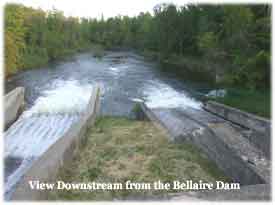
In practice, the water level have a fluctuation of several inches with
a significant rain or melt—even if the dam is wide open. Steep hills
in the Intermediate Lake watershed send water into the lakes very quickly
and cause sudden increases in the lake level. If the ground is already
saturated with moisture, the runoff accelerates—as it will with
the quick melt of snow pack during a spring heat wave. The stretch of
distance from Intermediate Lake down the shallow Intermediate River to
the dam and the convergence with the Cedar River delay the movement of
water from the lake—and the effects of changes of gates at the dam.
Just this spring, heavy rainfalls drove the lake level five inches above
normal and it took almost two weeks to drop back—even though all
the dam gates were open since the rains began.
However, most of the time the level is within an inch or so of the ordered
level. One thing is almost always true: the water level is either going
up or going down—it’s rarely remains static for more than
a couple days at a time—but that’s just Michigan weather at
work.
Tour
the Elk Rapids Hydro Dam.
Similar to the Bellaire Dam, the first dam at Elk Rapids was built with
the arrival of the first settlers and also powered the local sawmill.
Sometime in the late 19th century, the dam was electrified to supply the
growing iron foundry and related industries. The Elk Rapids Iron Company
conveyed the dam to the Elk Electric Company in the mid 1920s and it later
came into the ownership of Consumers Power Co. The dam was decommissioned
in the late 1950s and eventually came into the possession of Antrim County.
During the energy crisis of the late 1970s, the County took the opportunity
to recommission the facility as a hydroelectric dam, and the current generating
equipment was installed at that time. Concurrent with the recommissioning,
Antrim County contracted with Traverse City Light and Power to manage
the daily operation of the electricity generation.

In 2007, Antrim County contracted with a new group, Elk Rapids Hydroelectric
LLC (ERH), to operate the hydroelectric facility. ERH is a family-owned
enterprise (the Stockhausens) who are dedicated to the relicensing and
perpetuation of hydro power in Elk Rapids. Antrim County is now halfway
through the five-year licensing process with good prospects for success.
Thanks to the dedication of the Stockhausens, the facility is now running
in the black.
The
present day dam is located on Dexter Street in Elk Rapids, situated
between the upper (Elk Lake) and lower (Grand Traverse Bay) boat harbors
and is an integral part of the historic downtown and the recreational
waterfront, including the Edward R. Grace Harbor. The downstream side
of the dam is a popular fishing destination that attracts anglers from
all over Michigan.
The brick building visible from the exterior houses the generating
equipment. Built into its foundation are four separate chutes through
which the water flows. Only two contain generating turbines. The water
enters a chute through gates on the upper side and flows into a large
rectangular chamber. A cylindrical turbine housing sits in the middle
of the chamber with wicket gates at the top edge. Water flows through
the wicket gates and falls downward into the housing, pushing the turbine
blades as it falls. The turbine drives a shaft that extends through
the upper floor and drives the electric generator. All the generating
equipment is monitored 24 hours a day.
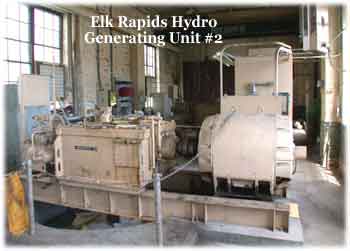
The summertime water level of Elk Lake was established by a circuit
court order at 590.8 feet above sea level in 1973. On November 1st
of each year, the order calls for the level to be dropped to 590.2.
The following spring, the lake level is raised to the summertime level
on April 15th (or ice break-up, if it occurs earlier).
For several
reasons, the Elk Lake level is easier to keep constant and less fluctuations
occur than on Intermediate Lake. The Elk Rapids Dam has considerable capacity
and is located close to Elk Lake, so more water can be moved more quickly
in response to rainfall. Also, the Elk River runs into Grand Traverse
Bay through another route and provides an overflow capacity independent
of the dam.
Why doesn’t
the Antrim County Drain Commissioner handle drainage issues like drain
commissioners downstate?
As explained above, the Antrim County Drain Commissioner’s statutory
duties are virtually non-existent. Antrim County never elected to create
legal drainage districts of the sort widely found in downstate Michigan.
Therefore, the Drain Commissioner has little power other than the duties
assigned by the County Board of Commissioners.
Historically, the drain commissioner was the authority that determined
where and how drainage ways were constructed to drain stormwater runoff
from the land for farmers. In the heavily agricultural (and flat) counties
of southern Michigan, drainage districts were commonly established and
the drain commissioner was one of the most influential of local politicians
with the power to assess taxes and condemn land for public projects. Today,
drain commissioners in many downstate counties continue to be important
political power brokers that now build sewers and other infrastructure
for modern development.
The ground of Antrim County never supported the intense agricultural activity
of downstate and the sandy nature of local soils lend themselves to quick
absorption of water. Therefore, the County never had the need to establish
legal drainage districts to handle runoff. As a result, the Antrim County
Drain Commissioner has no authority over drainage issues that arise in
the County. Drainage issues associated with the roadways are handled by
the Road Commission. Drainage issues related to building activity are
handled by the Antrim Conservation District (which administers the Soil
Erosion Control Program). Drainage issues between Antrim County landowners
have been ruled to be civil matters between the landowners.
One small drainage
district exists in Antrim County. It includes the area around Birch Lake
in Elk Rapids Township and was created to build a small sewer system to
pump into the Village of Elk Rapids’ sewage treatment plant. The
Drain Commissioner’s only involvement with that district is to maintain
the County easement that follows the small creek that drains Birch Lake
to the Grand Traverse Bay. Every few years, the Drain Commissioner organizes
a work party to clear the easement of debris and overgrowth that might
impede the flow.
How
to Contact the Drain Commissioner, Operator of Dams, Mark Stone:
The Drain Commissioner and the Operator of Dams are both part-time
positions and most of the work is done outside of normal business hours.
To contact me, it's best to email or call me during normal business hours
at my regular job as publisher of Michigan Maps in Elk Rapids. You may
also drop by the office at 104 Dexter Street, in the historic downtown.
Mark Stone, 231-264-6800 (Feel free to leave a message, if you get the machine.)
Email: mail@michiganmapsonline.com
Please direct official or legal correspondence to: Antrim County Operator of Dams (Drain Commissioner), P.O. Box 217, Bellaire, MI 49615 (231) 533-6265
For biographical information on Mark Stone, please click here.
